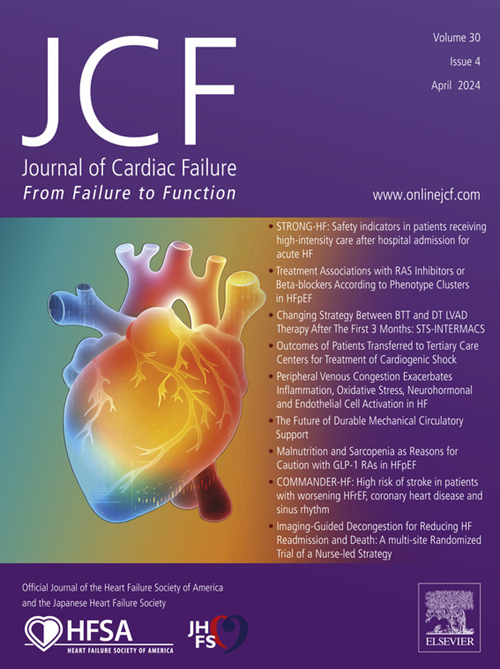Win Ratio Sensitivity Analysis Using A Modified Hierarchical Composite Outcome: Insights From The Paraglide-hf
IF 6.7
2区 医学
Q1 CARDIAC & CARDIOVASCULAR SYSTEMS
引用次数: 0
Abstract
Introduction
The win ratio (WR) is a promising alternative for reporting composite outcomes, prioritizing clinically significant events (e.g., mortality), while incorporating morbidity and surrogate measures. However, its benefits could be offset by limitations, mainly due to the large influence of lower hierarchical outcomes, such as biomarker outcome s. This secondary analysis of the PARAGLIDE-HF trial, which presented the WR in the primary paper, performed a WR sensitivity analysis using a modified hierarchical composite outcome to evaluate the utility of WR sensitivity analysis and assess the efficacy of sacubitril/valsartan (sac/val) vs. valsartan (val).
Methods
PARAGLIDE-HF compared sac/val with val in heart failure (HF) patients with ejection fraction (EF) >40% following a recent worsening HF event. A hierarchical outcome in the primary analysis consisted of 1) cardiovascular death, 2) HF hospitalizations, 3) urgent HF visits, and 4) change in N-terminal pro-B-type natriuretic peptide (NT-proBNP), considering a 25% proportional decrease as a win. In the pre-specified subgroup with EF≤60%, sac/val showed a treatment effect on the hierarchical outcome (WR, 1.46; 95% CI, 1.08-1.97). Sensitivity analyses for this subgroup with modifications to the hierarchy included: 1) excluding NT-proBNP change, 2) substituting the 25% proportion change of NT-proBNP with 10% or 50%, and 3) including the pre-specified renal outcomes within the hierarchical outcome. The WR was calculated as the percentage of the total number of wins over the total numbers of losses, and the win odds (WO) allocated 50% of the ties to both the numerator and denominator of the WR statistic.
Results
Among 466 randomized patients, 357 patients with EF 41-60% (median age 70 years, 49.3% women) were included in the analysis. Excluding NT-proBNP from the hierarchy favored treatment with sac/val vs. val (WR, 1.49; 95% CI, 1.00-2.22; WO, 1.12; 95% CI, 1.00-1.26). When adjusting the threshold for proportional change in NT-proBNP from 25% to either 10% or 50%, the win statistics consistently favor sac/val vs. val. Incorporating renal outcomes also favored sac/val vs. val (WR, 1.44; 95% CI: 1.07-1.94; WO, 1.28; 95% CI, 1.05-1.56).
Conclusions
Multiple Win Ratio sensitivity analyses support the treatment benefit of sac/val vs. val among HF patients with EF below normal. Future studies should consider prespecifying Win Ratio sensitivity analysis for comprehensive assessment of treatment effects.
求助全文
约1分钟内获得全文
求助全文
来源期刊

Journal of Cardiac Failure
医学-心血管系统
CiteScore
7.80
自引率
8.30%
发文量
653
审稿时长
21 days
期刊介绍:
Journal of Cardiac Failure publishes original, peer-reviewed communications of scientific excellence and review articles on clinical research, basic human studies, animal studies, and bench research with potential clinical applications to heart failure - pathogenesis, etiology, epidemiology, pathophysiological mechanisms, assessment, prevention, and treatment.
 求助内容:
求助内容: 应助结果提醒方式:
应助结果提醒方式:


